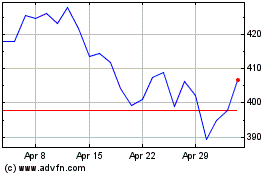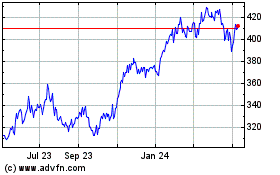By Telis Demos
Technology giants and big banks have been warily circling each
other, especially in the payments arena. So far, they are more
frenemies than rivals.
The reason: Banks are rapidly emerging as big potential
customers for the fast-growing, cloud-computing businesses of
Amazon.com Inc., Alphabet Inc., and Microsoft Corp. That is making
technology companies think twice about alienating them by becoming
direct competitors.
"We are very intentionally approaching banking customers with an
opportunity to empower them rather than to be in their space," said
Judson Althoff, executive vice president of world-wide commercial
business at Microsoft. "Banks see other cloud providers investing
in mobile payment capabilities, and there is a concern about
disintermediation."
With consumers increasingly turning to their mobile devices for
money transfers and financial advice, some analysts have predicted
that tech companies will supplant traditional banks as providers of
many banking services.
But the dynamic emerging is not so straightforward. The biggest
banks, such as JPMorgan Chase & Co. and UBS Group AG, are
themselves investing billions of dollars in new technology and, for
the first time, starting to use public cloud-computing platforms,
in which computing power and storage are purchased over the
web.
The leading providers of those fast and sophisticated shared
computing services include Amazon's AWS, Alphabet's Google Cloud
and Microsoft's Azure.
For years, banks had resisted moving sensitive data or processes
to the cloud, citing the security concerns of allowing data outside
of their leased or owned data centers. Financial firms also had
already invested billions into their own internal data platforms,
including so-called private clouds.
But recently, momentum shifted after regulators began using the
cloud for data storage and reporting, including the Financial
Industry Regulatory Authority, which works with Amazon's AWS. That
has led many banks to start doing the same.
Moving from traditional mainframes to the cloud also makes it
easier for banks to use artificial intelligence and other new
technologies that consume huge computing resources. This is used to
create better mobile products and trading tools.
"The ability of the banks to get out from under their legacy
cost pile is limited," said Jason Gurandiano, head of financial
technology banking at RBC Capital Markets. "So banks moving to the
cloud gives them leverage with the tech providers."
Cloud spending by banks is expected to skyrocket. By 2021, banks
globally are forecast to spend more than $12 billion on public
cloud infrastructure and data services, up from $4 billion last
year, according to market research firm International Data Corp.'s
public cloud spending guide.
By many metrics, the cloud business offers better opportunities
to tech firms than, say, retail banking. Overall cloud-industry
revenues are growing at about 60% year-over-year, Jefferies
estimates. Meanwhile, retail-banking revenue, comprising products
such as checking accounts and cards, at most big banks is growing
at a fraction of that rate. And any real foray into banking or
financial products could also entail substantial regulatory issues
and expense.
"Tech companies are going to get far more consistent and
repeatable revenue being infrastructure providers than by being in
banking," said Ami Grewal, head of digital strategy at GFT Group,
an engineering services firm that works with banks and partners
tech firms including Amazon and Google.
A handful of banks, such as Capital One Financial Corp., are
already significant cloud customers. Capital One began working with
Amazon in 2013, and made AWS its predominant cloud provider in
2016.The bank's deal has incentives for it to spend at least $150
million a year on the service, people familiar with the agreement
said. A spokesman for the bank declined to comment.
The upshot is that while big tech firms continue to dabble in
banking services, they tend to do so almost entirely through
banking partners.
For example, Amazon, Google and Microsoft offer digital wallets
that allow users to link their bank-issued credit and debit cards.
Citigroup Inc. enables its credit-card customers to pay for goods
at Amazon using credit-card rewards points.
Amazon's AWS, says working with banks is a top priority. Frank
Fallon, vice president for global financial services at AWS, told
the Journal that "interest has grown exponentially over the last
few years" in cloud services in the financial-services industry.
Rather than competing with banks, he said AWS was instead focused
on making sure it was offering the best security, performance, and
function. AWS's team "keep financial services customers at the core
of everything we do," he said.
Tariq Shaukat, president for global alliances and industry
platforms at Google Cloud, said Google begins meetings with banks
by assuring them they aren't interested in gathering banking data
for its own sake.
"We see ourselves as an enabler and platform for many of those
institutions, as opposed to in any way trying to compete with them
in their core businesses," he said. "We start cloud conversations
with an ironclad rule: A customer's data is a customer's data."
Microsoft said last year it had partnered with Bank of America
Corp. to work on public-cloud applications for the bank. As
recently as 2016, top Bank of America executives said they didn't
see a way to use the public cloud, due to security risks.
Cathy Bessant, the bank's chief operations and technology
officer, said the lender was still only spending a small part of
its $3 billion annual computing infrastructure budget on public
cloud. The bank now plans to increase that, following a rapid
improvement in security technology, and with a variety of
partners.
Ms. Bessant added that the firm takes into consideration the
possibility of tech partners someday seeking to compete with banks,
in part by learning from banks' own data. "We're not naive to that
potential," she said. "We're sensitive to making sure that...we
work with infrastructure providers that are like-minded and have
our best interests at heart."
Write to Telis Demos at telis.demos@wsj.com
(END) Dow Jones Newswires
April 26, 2018 12:18 ET (16:18 GMT)
Copyright (c) 2018 Dow Jones & Company, Inc.
Microsoft (NASDAQ:MSFT)
Historical Stock Chart
From Mar 2024 to Apr 2024

Microsoft (NASDAQ:MSFT)
Historical Stock Chart
From Apr 2023 to Apr 2024
